Applying Gauss' Law: Spherical Symmetry
Important Questions on Applying Gauss' Law: Spherical Symmetry
The figure given below is a section of a conducting rod of radius and length inside a thin-walled coaxial conducting cylindrical shell of radius and the (same) length The net charge on the rod is that on the shell is . What are the (a) magnitude and (b) direction (radially inwards or outwards) of the electric field at radial distance What are (c) and (d) the direction at What is the charge on the (e) interior and (f) exterior surface of the shell?
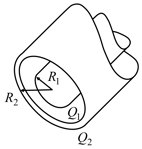
A charged particle is suspended at the center of two concentric spherical shells that are very thin and made of nonconducting material. Figure (a) shows a cross-section. Figure (b) gives the net flux through a Gaussian sphere centered on the particle, as a function of the radius of the sphere. The scale of the vertical axis is set by (a) What is the charge of the central particle? What are the net charges of (b) shell and (c) shell
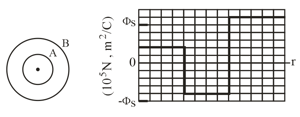
(a) (b)
A square metal plate of edge length and negligible thickness has a total charge of . (a) Estimate the magnitude of the electric field just off the center of the plate (at a distance of from the center) by assuming that the charge is spread uniformly over the two faces of the plate. (b) Estimate at a distance of (larger relative to the plate size) by assuming that the plate is a charged particle.
When a shower is turned on in a closed bathroom, the splashing of the water on the bare tub can fill the room's air with negatively charged ions and produce an electric field in the air as great as Consider a bathroom with dimensions Along with the ceiling, floor, and four walls, approximate the electric field in the air as being directed perpendicular to the surface and as having a uniform magnitude of . Also, treat those surfaces as forming a closed Gaussian surface around the room's air. What are (a) the volume charge density and (b) the number of excess elementary charges per cubic meter in the room's air?
Space vehicles traveling through Earth's radiation belts can intercept a significant number of electrons. The resulting charge buildup can damage electronic components and disrupt operations. Suppose a spherical metal satellite in diameter accumulates of charge in one orbital revolution. Find the resulting surface charge density. Calculate the magnitude of the electric field just outside the surface of the satellite, due to the surface charge.
Flux and conducting shells. A charged particle is held at the center of two concentric conducting spherical shells. Figure shows a cross section. Figure gives the net flux through a Gaussian sphere centered on the particle, as a function of the radius of the sphere. The scale of the vertical axis is set by . What are the charge of the central particle and the net charges of shell and shell ?

(a) (b)
Figure shows three plastic sheets that are large, parallel, and uniformly charged. Figure gives the component of the net electric field along the -axis through the sheets. The scale of the vertical axis is set by What is the ratio of the charge density on sheet to that on sheet ?
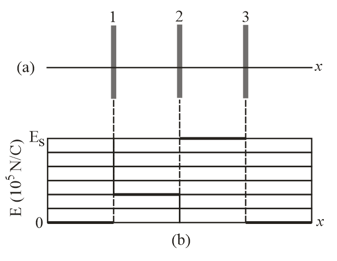
The figure shows two nonconducting spherical shells fixed in place. Shell has uniform surface charge density on its outer surface and radius ; shell has uniform surface charge density on its outer surface and radius the shell centers are separated by In unit-vector notation, what is the net electric field at
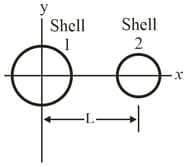
The figure shows a cross-section through a very large nonconducting slab of thickness and uniform volume charge density The origin of an -axis is at the slab's center. What is the magnitude of the slab's electric field at an -coordinate of and
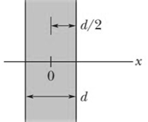
Assume that a ball of charged particles has a uniformly distributed negative charge density except for a narrow radial tunnel through its center, from the surface on one side to the surface on the opposite side. Also, assume that we can position a proton anywhere along the tunnel or outside the ball. Let be the magnitude of the electrostatic force on the proton when it is located at the ball's surface, at radius . As a multiple of , how far from the surface is there a point where the force magnitude is if we move the proton away from the ball and into the tunnel?
The square surface shown in the figure, measures on each side. It is immersed in a uniform electric field with magnitude and with field lines at an angle of with a normal to the surface, as shown. Take that normal to be directed outward, as though the surface were one face of a box. Calculate the electric flux through the surface. If the angle is reduced by a few degrees, does the flux increases or decreases or remains same.
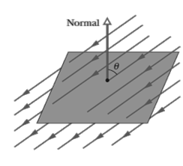
The electric field just above the surface of the charged conducting drum of a photocopying machine has a magnitude of What is the surface charge density on the drum?

